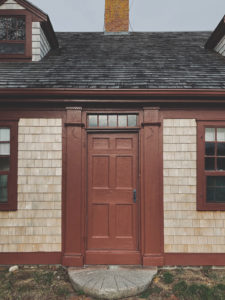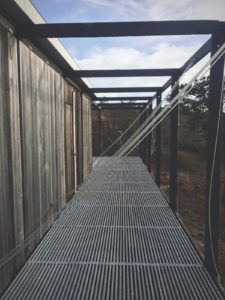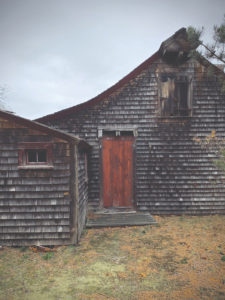Following the roads and paths of Wellfleet’s Bound Brook Island, you’ll find hillsides covered with bearberry and stands of winterberry along the now-still tidal brook below. There are houses, too — historic ones that still shape the identity of this place.
The Atwood-Higgins House, built in 1730, is the oldest house within the Cape Cod National Seashore. In 1920, it was inherited by George Higgins. He spent 40 years restoring the house before giving it to the National Park Service in 1961, the year the National Seashore was created.
The house is surrounded by a collection of rambling structures that suggest a village. Grayed out and fading into the landscape, these buildings turn out to be the product of Higgins’s romantic Colonial Revival vision.
But the original house, now tended by National Seashore staff and opened in summer for tours, remains a fine example of the Cape Cod style. On a sunny winter walk, stop outside the house to consider one of its cleverest features, a protected south-facing façade.
Up the road towards the beach lies the Baker-Biddle property. The National Park Service is also the steward for this historic place, where four buildings dating from 1690 to 1850 are clustered on 10 acres of land. Whale processing, historians say, happened here. Lorenzo Dow Baker, Wellfleet’s “Banana King,” was born here. Later, it became a retreat where literary and political luminaries gathered — John Dos Passos and Judge Francis Biddle among them.
There is proof this place was home to many others, longer ago. National Park archaeological investigations in 2012 uncovered ancient tools, pottery, and coins on this land — layers of history that could date back as far as 5,000 years.
Nearby, built above a glacial kettle hole, the Hatch House shakes up the traditional idea of what a home should look like.
The house was designed by self-taught architect, carpenter, and painter Jack Hall for Robert Hatch, executive editor of The Nation, and his wife, the painter Ruth Hatch. Perched on a few concrete pilings in the sand, the outdoors connects the inner spaces made of rectangular boxes sheathed in vertical fir boards.
Originally built in 1962, the house was restored by the Cape Cod Modern House Trust in 2012. Along with the Atwood-Higgins House, it is listed on the National Register of Historic Places.
As if with you on your walk, Peter McMahon of the Modern House Trust writes in his book, Cape Cod Modern, that arriving here, this place evokes “the most visceral, astonished response, even from veteran architects.”



